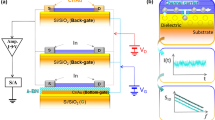Abstract
The hot-carrier effect, which is caused by the generation of interface states, is the main degradation mechanism for MOSFETs. Predicting the degradation of circuit performance due to the hot-carrier effect is important for practical circuit design. In this paper, we propose a small-signal model considering the hot-carrier effect by establishing time-dependent model parameters, which is verified by small-signal simulation and measurement for 40-nm-process MOSFETs at millimeter-wave (mmW) frequencies. In the proposed small-signal model, the shift of relaxation time of the non-quasi-static (NQS) effect is investigated and verified for mmW frequencies for the first time. By comparing simulation and measurement results, it is shown that the shift of relaxation time of the NQS effect should be considered for the prediction of MOSFETs performance degradation at mmW frequencies.





Similar content being viewed by others
Change history
22 September 2022
A Correction to this paper has been published: https://doi.org/10.1007/s10762-021-00782-x
References
C. Guerin, V. Huard, and A. Bravaix, “The energy-driven hot-carrier degradation modes of nMOSFETs,” IEEE Transactions on Device and Materials Reliability, vol. 7, pp. 225–235, June 2007.
S. E. Rauch, F. J. Guarin, and G. LaRosa, “Impact of E-E scattering to the hot carrier degradation of deep submicron NMOSFETs,” IEEE Electron Device Letters, vol. 19, pp. 463–465, Dec 1998.
S. Naseh, M. J. Deen, and O. Marinov, “Effects of hot-carrier stress on the RF performance of 0.18 μm technology NMOSFETts and circuits,” in Proc. of 40th Annual Reliability Physics Sposium Proceedings, pp. 98–104, 2002.
C. Hu, S. C. Tam, F.-C. Hsu, P.-K. Ko, T.-Y. Chan, and K. W. Terrill, “Hot-electron-induced MOSFET degradation - model, monitor, and improvement,” IEEE Journal of Solid-State Circuits, vol. 20, pp. 295–305, Feb 1985.
I. Kurachi, N. Hwang, and L. Forbes, “Physical model of drain conductance, gd, degradation of NMOSFET’s due to interface state generation by hot carrier injection,” IEEE Transactions on Electron Devices, vol. 41, pp. 964–969, Jun 1994.
C. Hu, W. Liu, et al., “Bsim3v3. 2.2 mosfet model. usersí manual,” UC Berkley, 1999.
J.-T. Park, B.-J. Lee, D.-W. Kim, C.-G. Yu, and H.-K. Yu, “RF performance degradation in nMOS transistors due to hot carrier effects,” IEEE Transactions on Electron Devices, vol. 47, pp. 1068–1072, May 2000.
E. Takeda and N. Suzuki, “An empirical model for device degradation due to hot-carrier injection,” IEEE Electron Device Letters, vol. 4, pp. 111–113, Apr 1983.
B. Dubois, J. B. Kammerer, L. Hebrard, and F. Braun, “Analytical modeling of hot-carrier induced degradation of MOS transistor for analog design for reliability,” in Proc. of 8th International Symposium on Quality Electronic Design (ISQED), pp. 53–58, March 2007.
L. Negre, D. Roy, S. Boret, P. Scheer, N. Kauffmann, D. Gloria, and G. Ghibaudo, “Hot carrier impact on the small signal equivalent circuit,” in IEEE International Integrated Reliability Workshop Final Report, pp. 72–75, Oct 2010.
L. Negre, D. Roy, F. Cacho, P. Scheer, S. Boret, A. Zaka, D. Gloria, and G. Ghibaudo, “Aging of 40nm MOSFET RF parameters under RF conditions from characterization to compact modeling for RF design,” in Proc. of IEEE Radio Frequency Integrated Circuits Symposium (RFIC), pp. 1–4, 2011.
L. Negre, D. Roy, S. Boret, P. Scheer, D. Gloria, and G. Ghibaudo, “Advanced 45nm MOSFET small-signal equivalent circuit aging under DC and RF hot carrier stress,” in Proc. of IEEE International Reliability Physics Symposium (IRPS), pp. HV.1.1–HV.1.4, 2011.
A. Bravaix, V. Huard, D. Goguenheim, and E. Vincent, “Hot-carrier to cold-carrier device lifetime modeling with temperature for low power 40nm Si-bulk NMOS and PMOS FETs,” in Proc. of IEEE International Electron Devices Meeting (IEDM), pp. 27.5.1–27.5.4, 2011.
D. Ang, T. Phua, H. Liao, and C. Ling, “High-energy tail electrons as the mechanism for the worst-case hot-carrier stress degradation of the deep submicrometer n-MOSFET,” IEEE Electron Device Letters, vol. 24, no. 7, pp. 469–471, 2003.
K. Katayama, M. Motoyoshi, K. Takano, and M. Fujishima, “THz matrix-based layered wrapper model of common-source MOSFET,” in Extended Abstracts of the International Conference on Solid State Devices and Materials, Japan Society of Applied Physics, sep 2012.
K. Katayama, M. Motoyoshi, K. Takano, R. Fujimoto, and M. Fujishima, “Bias-voltage-dependent subcircuit model for millimeter-wave CMOS circuit,” IEICE transactions on electronics, vol. 95, no. 6, pp. 1077–1085, 2012.
S. P. Sinha, F. L. Duan, D. E. Ioannou, W. C. Jenkins, and H. L. Hughes, “Time dependence power laws of hot carrier degradation in SOI MOSFETs,” in Proc. of IEEE International SOI Conference, pp. 18–19, 1996.
C. C. Enz and C. Yuhua, “MOS transistor modeling for RF IC design,” IEEE Journal of Solid-State Circuits, vol. 35, no. 2, pp. 186–201, 2000.
M. Chan, K. Y. Hui, H. Chenming, and P. K. Ko, “A robust and physical BSIM3 non-quasi-static transient and AC small-signal model for circuit simulation,” IEEE Transactions on Electron Devices, vol. 45, no. 4, pp. 834–841, 1998.
D. Ferry, Semiconductor transport. CRC Press, 2000.
T. Matsuoka, S. Taguchi, Q. D. M. Khosru, K. Taniguchi, and C. Hamaguchi, “Degradation of inversion layer electron mobility due to interface traps in metal-oxide-semiconductor transistors,” Journal of Applied Physics, vol. 78, no. 5, pp. 3252–3257, 1995.
Y. C. Cheng and E. A. Sullivan, “Effect of coulomb scattering on silicon surface mobility,” Journal of Applied Physics, vol. 45, no. 1, pp. 187–192, 1974.
Y. Matsumoto and Y. Uemura, “Scattering mechanism and low temperature mobility of MOS inversion layers,” Japanese Journal of Applied Physics, vol. 13, no. S2, p. 367, 1974.
Author information
Authors and Affiliations
Corresponding author
Additional information
Publisher’s Note
Springer Nature remains neutral with regard to jurisdictional claims in published maps and institutional affiliations.
Rights and permissions
Springer Nature or its licensor holds exclusive rights to this article under a publishing agreement with the author(s) or other rightsholder(s); author self-archiving of the accepted manuscript version of this article is solely governed by the terms of such publishing agreement and applicable law.
About this article
Cite this article
Li, C., Chye, B.C., Yang, Y. et al. MOSFET Small-Signal Model Considering Hot-Carrier Effect for Millimeter-Wave Frequencies. J Infrared Milli Terahz Waves 40, 419–428 (2019). https://doi.org/10.1007/s10762-019-00574-4
Received:
Accepted:
Published:
Issue Date:
DOI: https://doi.org/10.1007/s10762-019-00574-4




